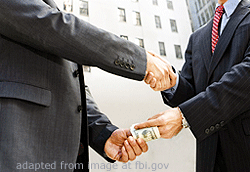Russian Business Climate, Corruption Hold Back Rating, S&P Says

(Bloomberg – bloomberg.com – Scott Rose – October 16, 2012) Russia needs a better business climate to bolster economic growth and win an upgrade of its investment-grade credit rating, according to Standard & Poor’s.
The government must deal with “structural impediments” to growth by fighting corruption, scaling back the state’s role in the economy and improving the judiciary, while moving away from the spending increases President Vladimir Putin has counted on for popularity, Kai Stukenbrock, S&P’s head of sovereign ratings for the Commonwealth of Independent States and the Middle East, said in an interview.
Tackling graft “could help the growth potential and also the resilience of the economy,” he said today in Moscow. “The question is whether the government will be able to change their mode of operation and curtail expenditure growth.”
Russia, the world’s largest energy exporter, is trying to reduce its dependence on the oil and gas revenue that accounted for half its income last year. Putin wants to boost investment to 25 percent of gross domestic product by 2015 from 21 percent last year by improving the country’s ranking in the World Bank’s annual Ease of Doing Business survey to 20th from 120th.
While “ambitious,” that target may help focus the government and reduce state interference in the affairs of businesses and investors, according to Stukenbrock.
‘Align Policy’
“It’s good to have goals and targets and to say ‘we want to move up,'” he said. “It would help to align policy a bit in a certain direction.”
Russia is rated BBB at S&P, the second-lowest investment grade and level with Bulgaria and Lithuania. The rating, which has a stable outlook, remains vulnerable to a sustained drop in crude prices, according to Stukenbrock.
Oil prices lingering at $80 a barrel could result in a one- step downgrade for Russia, while a prolonged run of $60 crude may trigger a three-step cut to a BB junk rating, he said.
Urals crude, Russia’s main export blend, has advanced 7.9 percent this year to $114.01 a barrel, according to data compiled by Bloomberg. It’s averaged almost $111 in 2012.
Crude and oil products account for half of Russian goods exports, a figure that rises to 80 percent when gas and metals are included, according to S&P. A $10 drop in average oil prices can widen Russia’s budget gap by 1.4 percent of GDP.
The government is targeting an A rating, citing a lower debt load than in many higher-rated countries, according to the Finance Ministry’s medium-term debt strategy.
While the sensitivity of the budget and the economy to oil hasn’t changed “dramatically,” there are signs Russia is making steps toward sheltering itself from energy-price shocks, Stukenbrock said, citing the central bank’s move toward a more flexible ruble exchange rate and World Trade Organization entry.
The Finance Ministry is taking a lot of “smallish steps” toward improving Russia’s fiscal outlook, including proposing a “relatively conservative” budget for next year, introducing caps on spending, opening the debt market to foreign investors, and borrowing more than needed to replenish the Reserve Fund, according to Stukenbrock.
“Taken all together, I think there’s a lot of sensible policy coming from that side at the moment,” he said.
©2012 BLOOMBERG L.P. ALL RIGHTS RESERVED; article also appeared at http://www.bloomberg.com/news/2012-10-16/russian-business-climate-corruption-hold-back-rating-s-p-says.html
